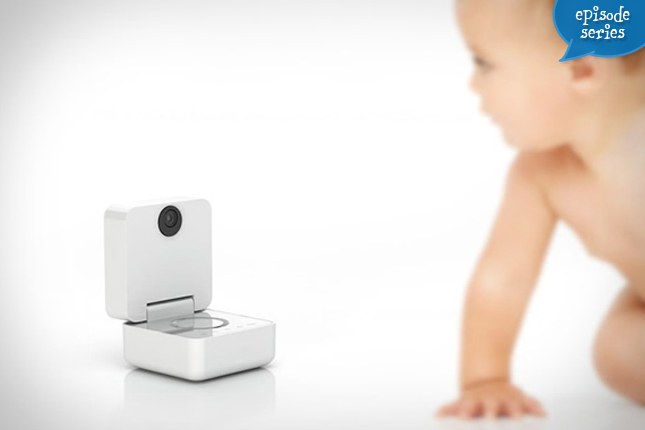Twin Talks
Twin Baby Gear Essentials: Baby Monitors
[00:00:00]
Please be advised, this transcription was performed from a company independent of New Mommy Media, LLC. As such, translation was required which may alter the accuracy of the transcription.
[Theme Music]
SUNNY GAULT: Keeping track of one baby is tough. Add another baby to the mix and the situation can get really crazy. Baby monitors are great for helping twin parents keep toes on their little ones. But with so many options to choose from, how do you know which one to pick? Today we’re exploring the different features available on baby monitors designed to keep your kiddos safe. This is twin talks.
[Theme Music/Intro]
SUNNY GAULT: Welcome to Twin talks, broadcasting from the birth education centre of San Diego. Twin Talks is your weekly online on the go support group for expecting and new parents of twins. I’m Sunny Gault, and I’m sitting in as your host for today. Have you heard about the Twin Talks club?
Our members get bonus content after each new show, plus special giveaways and discounts. You can subscribe to our Twin Talks newsletter and learn about the latest episodes available. Another great way for you to stay connected is by downloading our free Twin Talks app. It’s available in the iTunes, Android as well as Windows marketplace. So before we get going with today’s conversation, let’s introduce some of the people that we’re going to be talking to today. Really we’ve got myself and Brandi here is joining me in the studio as a panellist. Brandi I’ll let you go first, tell us a little bit about yourself and your twins
BRANDI WALLACE: Sure. My name is Brandi Wallace. I have two sets of twins. The older twins are identical boys that are just a few days shy of turning five. And the younger sets are fraternal boy girl twins that just recently turned two
SUNNY GAULT: Okay and you guys know me but I’ll introduce myself as well. So I have four children. And my oldest is four, it’s a boy. And I have a two year old son. And then I have twins as well, mine are identical girls who are about to turn one next week.
[Theme Music]
SUNNY GAULT: Okay. It’s time for a really fun segment on the show. It’s called “We’re expecting what?” And it’s our chance to show your awesome stories of how you found out you’re pregnant with twins. And this comes from Kesha.
Kesha is writing us from Alabama. And Kesha says, I was the one who would always say, I don’t know what I would do if I had twins. Or, I don’t see how people do it with twins or more than three kids. Well, I’m twenty eight years old, I had my two girls first who are now ages seven and five. When I got pregnant, I decided that I was going to have my tubes tied. I thought three was enough and me and my husband were wishing for a little boy.
When I went to my first ultrasound, I had to have a full bladder. I’ve been drinking water all morning. So when I got to my appointment my bladder was full. I could no longer hold it. So they call me back to get a couple of ultrasound pictures before I could empty my bladder. When I got back, the doctor and the ultrasound lady were waiting. I was thinking there must be something wrong.
She asked me to lay down so she could complete the ultrasound. Then she asked what the sexes of my kids at home were. I told her two girls. Then she told me, well you’re now having two boys. I started crying and I asked her, did you say two? Two of what? We were in shock for a long time. I had a normal pregnancy, never got sick and went into labour at thirty seven and a half weeks. And it was actually on my husband and I’s anniversary. And yes, I got my tubes tied. No more surprises. I love this story. I think that’s so great.
I’m so glad you got your little boy, I have a similar story where I was just hoping for a little girl, I already had two boys so it was pretty much the exact opposite of you Kesha. And I got my little girls too so two and two for both of us. How awesome is that? Kesha thanks so much for writing this and for listening to our shows
[Theme Music]
SUNNY GAULT: Today we’re continuing our series focused on twin baby gear essentials. And these are items that we believe can really help twin parents just kind of ease the burden. Keep track of their kids a little bit easier. Today our expert is Julie Vallese, she is the consumer safety expert with Safety First. Julie thanks so much for joining us today on Twin Talks.
JULIE VALLESE: Sunny it’s great to be here with you, thanks for having me
SUNNY GAULT: Absolutely. So what are some of the benefits of using a baby monitor. Why would, not just twin parents but even parents in general, how does it help parents?
JULIE VALLESE: Baby monitors really give you a little bit of that piece of mind. You put your child in the nursery, put them down for a nap and you do know that that’s really the safest place in your home for your baby where you can walk away. But by having a monitor you’re able to keep track. You can either see them if you have a video monitor or hear them because you were able to respond to their needs and know whether do you need to check or can you give them just a little minute or two so that they can put themselves back to sleep
SUNNY GAULT: So I have to ask Brandi, as a mother of two sets of twins now, I would imagine having a second pair of eyes, ears whatever to help monitor your twins would be very helpful. What’s been your experience with baby monitors?
BRANDI WALLACE: Oh they have been life saver for us actually. The almost five year old boys still have monitors in their room. I think they just think it’s a fixture in our home that is, comes automatically in every home
SUNNY GAULT: Right.
BRANDI WALLACE: We have one, we don’t have the monitors that pan and tilts, so we have with two one on one positioned on each bed. And then we also have same for the cribs for the smaller children as well. And, you know being a parent of twins, one of the benefits of having for us a video monitor, I need extra eyes, not just the ears is that if I just have ears and I heard a cry, how do I know which child is crying? And the video monitors that came in handy because I would a cry and I would look and there’s the baby crying and hear a cry again I’d look oi! That’s a different baby. That’s not the same baby. So, then it lets you know how to parent better same child having a long issue or two short issues with two different children. So that’s been very helpful
SUNNY GAULT: So, two cameras then on each
BRANDI WALLACE: Four cameras that all report back to the same handheld monitor
SUNNY GAULT: That’s like a surveillance system
BRANDI WALLACE: It is. I will use them until they turn eighteen and move out of my home
SUNNY GAULT: And when they’re trying to sneak in you can know when they’re teenagers
BRANDI WALLACE: Well even the sneaky one, when they get older and convert to a big kid bed
SUNNY GAULT: Yeah.
BRANDI WALLACE: They would just sometimes sneak out of bed and I can watch them and have this booming voice come from the hallway "get back in your bed”
SUNNY GAULT: Yes exactly
BRANDI WALLACE: And they don’t know where, how I know that but
SUNNY GAULT: Mother has eyes everywhere
BRANDI WALLACE: It’s true, so they’ve been very helpful
SUNNY GAULT: Okay. So, Julie what are the basic components or parts that are involved in baby monitors and how difficult are they to use?
JULIE VALLESE: Baby monitors really run the game. So you do look at the price. You do look at how many of the cameras will you need. How big of an area are you trying to monitor at any given time? So, most monitors will come with a base unit and a camera unit and then you can add additional cameras that feedbacks to that base
SUNNY GAULT: Okay
BRANDI WALLACE: And that’s what we’ve done
SUNNY GAULT: That’s what you’ve done. You can add like additional monitors to it. You know I had a situation so, I had a video monitor, I got it with my first born son. And we kind of used it with my second son as well. Once my second son came along it really became a monitor for both of them. And I went online because I thought, well I’ve got two babies now, I want to, you now get a second video monitor.
And it was one of those situations where our model, like they were no longer producing our model. And I’m like “oh no” but there were some different things that you can go Craig’s list or whatever and try to find them. I never really went that far. But I remember thinking “oh it would be really nice to be able to add on to that and be able to kind of have a grow with your family” and now I could totally you know use that in the case of my twins.
Julie, let’s talk about the features, you know a lot of different features out there now and I kind of wanted to go through and talk about what parents should look for if they’re considering these features. So, the first point that I wanted to bring up is analog versus digital. What can you tell us about that?
JULIE VALLESE: Analog versus digital is basic and then a little more technology. Analog is basic radio waves. One of the things is that analog monitors will be less expensive but think about where you live. If you’re on a densely populated area, if you live in an apartment building, analogs are also much more susceptible to interference.
Where other people may be able to come across your radio waves and hear as well. Additionally if there are other families that have analogs, you may end up hearing their signals also. Digital are a little more secure. They have more difficulties for people listening in so that they in some models are encrypted in their signals. But digital is a little, a little more difficult for anyone else to hear. Also, digital is a little more crisp in terms of what you will hear and what you may see. Analog there could be interference in static and may not give you quite as clear of a signal
SUNNY GAULT: Okay. Brandi, you know, do you have analog, digital?
BRANDI WALLACE: I don’t know. I left that out to my husband
SUNNY GAULT: If you had the video, Julie do they actually make analog for video or is all video digital do you know?
JULIE VALLESE: Pretty much all the video is digital because of what’s needed to transmit a video signal
SUNNY GAULT: Okay
BRANDI WALLACE: I feel like the only issue that may have come up with us and I don’t want to throw this out there and not have an answer for it but I feel like maybe there was a thing with that video signal getting to our monitor may have had interference from our wifi. If something we read about that
SUNNY GAULT: There is something. There is something about that I recently had the people that handle our internet. They came out to the house and we have a monitor, just a monitor plugs into the wall that kind of hooks up to our baby monitor. And it was downstairs, and we were complaining to the guy that we weren’t getting, you know whatever the download speed that we were supposed to be getting. And he looked over the baby monitor and he’s like, is that cause, you know that could be causing interference. I’m like, honestly we hardly ever turn that thing on. I’d be really surprised. Julie have you heard anything about baby monitors and how it affects wifi?
JULIE VALLESE: Well, absolutely, you know, all of us are just going so wireless. So, you do have to take in to consideration what are the wireless devices you have in your home. If you have cordless phones and radios, and even the microwave oven, all of these things can cause interference in a wireless baby monitor. Depending how close you are to your neighbour, even their wireless devices can cause problems in interference. And so, those are things that you do need to take in consideration in terms of you know how technological is your home and how much wireless do you have going on
SUNNY GAULT: Yeah. Absolutely
BRANDI WALLACE: But I have a question for you Sunny. What do you think about those video and or I guess the video monitors that allow parents to look at the signal on their phone or on their computer at work
SUNNY GAULT: Oh yeah. The ones and I definitely wanted to touch on that because there’s some that hook up to apps that you can download and stuff like that. I’d love the concept of it, it does, and this kind of leads to the next point too, but it does kind of worry me a little bit about security. And if I can see it, can other people see it and all that kind of stuff. So I love, I love what it can do for parents that can’t be at home or right near their babies all the time. But I do have some concerns. So, Julie when it comes to security, I know we talked a little bit about wireless and how or digital I guess I should say, and how that might be a little bit more secure. Is there anything we should be looking for specifically on monitors besides of being digital that might make monitors, the images and everything we hear be a little bit more secure?
JULIE VALLESE: The difference in digital is their digital baby monitors. And then then the higher end was the ones that are really taking technology to that next step will encrypt that signal so that it is more secure. So I think when you’re looking at a digital monitor asking questions and looking to see if any of the products end up having encryption or encoding to them which do makes them a little bit more secure in their safety
SUNNY GAULT: Okay. And those are probably be monitors that might be a little bit more expensive because it’s got this additional feature correct?
JULIE VALLESE: Anytime you’re adding those kinds of features there does end up being a cost involved.
SUNNY GAULT: Yes. Okay. Alright when we come back we’re going to continue to breakdown these features available on baby monitors including monitors, we kind of alluded to these before that connect to your smart phones, so we’ll be right back
[Theme Music]
SUNNY GAULT: Welcome back, today we’re talking with Julie Vallese, she’s the consumer safety expert for Safety First and we’re talking about what features to look for in a baby monitor. So, let’s go ahead and continue with our list. So the size of the monitor, Julie it comes in all different types of sizes both the transmitter as well as a receiver. What should parents know about the size?
JULIE VALLESE: One thing about the size that parents should really remember is that they have been built so that they can see a fairly large range of the crib or the room. One of the mistakes that sometimes parents will make is they feel because it’s small, it also needs to be very close to the crib or the baby. But in fact, you do need to make sure that the placement is at a minimum three feet away from the sleeping environment.
It’s really recommended six feet away from the sleeping environment. So there aren’t any safety hazards that go along with that video heard of the monitor itself. But the size doesn’t necessarily mean small size, small viewing space. So taking a look at what is the range, what is the visibility is something that parents should keep in mind
SUNNY GAULT: Okay. Brandi, how big is your monitor? Was it big or small? Was that a factor in you picking a monitor?
BRANDI WALLACE: You know, when we purchased ours and this was over five years ago because we started with our first set and then we’re lucky enough that we still had that one on the market when we added to it. But it was on its way out so we’re hanging on to the technology right now. But at the time, there was handheld and then there was desktop I guess. I mean there was one that almost looked about the size of a small smart tablet
SUNNY GAULT: Okay
BRANDI WALLACE: You know, a small tablet. But we opted for the handheld one just because I figured we’re going to be all over the place and I didn’t want to just have one on my nightstand. That wasn’t the only time I was going to want to see them. And so the one we have, people confused for a cellphone all the time, they think that my monitor is a cellphone because it’s about the size of a deck of cards
SUNNY GAULT: Oh yeah
BRANDI WALLACE: And it has a little screen on there that they seriously think it’s a phone all the time. And that it has a clip, I clip it on my belt so I can listen as I walk around the house without looking at it and then if I need to see what I’m hearing, I just push the little screen on and look at them.
SUNNY GAULT: There’s a feature that I saw, I have a friend that had a monitor that allowed you to talk to your child through. It kind of the same size as what you’re talking about. And it was genius because she would be downstairs and her son would be upstairs. And you know trying to get her son to sleep and she wouldn’t want to go upstairs and say “now lay back down” so she could see it.
It was very small, it had a little tiny monitor built in to it and she pushes little button and she could say “now sit down, sit down, lay back down” and you know to the baby, you know it’s just hearing his mom’s voice or whatever. You know the baby did exactly, and you know she was just sitting at the table the whole time. I’m like, I want that monitor
BRANDI WALLACE: I want that house. My house isn’t large enough to be that. I can just holler through the walls
SUNNY GAULT: I know right. Okay so, kind of to go along with that, another thing and my monitor actually has these too, and that’s sound activated light. So, what I mean by light is that it kind of, it shows you different levels, you know. And if it gets, the loudness gets to screaming, crying point it actually turns a different colour. So, what’s nice about this is if you are a visual person and you don’t necessarily want to sound up, you can kind of visually see these levels and be able to tell, you know what’s going on with your child. And it was nice for me to be able to have that simply because, and again maybe I have an older monitor but if I turn on the monitor so I can hear the sound, I can also hear a lot of like hum or buzz or something. I don’t think it’s an interference thing, I just that I have an older monitor. And it’s certainly not like super quiet. So you know if I didn’t want to like, hear that I could kind of see the sound activated light. So that’s another feature that you know I’ve seen on baby monitors that seems to help
JULIE VALLESE: That’s a really great feature for families with multiples. Because, if there is crying sometimes when one cries, the other one starts. So having those visuals it ends up being able to manage situations of what the children are doing. But it also lets you take a little more relaxation when the kid do go down so that if you’re watching TV or you’re talking on the phone, you’re able to take those visual cues instead of actually hearing them
SUNNY GAULT: Yeah. Absolutely! Yeah I forgot that sometimes my house was crazy noisy. And even if I had it up full blast, I might not even be able to distinguish cries and screams and all that kind of stuff. So, yeah that’s a great point. Julie, when it comes to cords and things being wireless, what do we need to know? I mean, I know one issue that I have with my monitor is that, the monitor, so it’s a video monitor that goes you know inside the nursery and right now I kind of have pointed at both of my twins cribs. If I get it too close, it’s a mistake I made with my oldest son, he would try to yank on it. He would pull it, I can’t tell you how many times I’d go into his room, you know, he would pull the cord like the cord which is kind of detach. So he would pull it apart, he would try to find the cord behind the crib. And this kid was like a magician and trying to get this thing and disconnect it. So what advice do we have for parents out there when it comes to cords and the positioning I guess of their monitors?
JULIE VALLESE: Well the cords are dangerous. And any cord whether it’s the baby monitor chord or light cords, anything in the nursery they do need to be attended too. As I mentioned before, minimum of three feet away from any sleeping environment so it’s really recommendation of six feet. And as we said, you know, the baby monitor becomes a fixture in your home. And so as your child grows, you need to keep in mind the position of that monitor may need to change. Because baby’s reach one week may be further the next week as they grow. So you need to keep in mind that how your baby moves around in the crib and their access to them. Because they can be a danger and that should be addressed on a regular basis. The other thing that I would mention about just the cord, a lot of people have switched over sometimes to monitors that are powered by batteries and powered by AC adaptor. And so keeping in time, looking for one, so that can be powered both by batteries and an adaptor so that when there’s a power failure, you don’t lose that extra set of eyes and ears
SUNNY GAULT: Oh that’s a really good point. Yeah, I didn’t think about power outages and that affecting everything. What do you have? Did you just have cords? What do you have?
BRANDI WALLACE: It’s exactly what she was just speaking about. I have the AC adaptor. I plug it in at night when it’s on my night stand and throughout the day it’s battery powered and I charge it every night
SUNNY GAULT: Yeah. I think I have one that has like, it almost, it’s not quite as small like a cellphone. It looks more like kind of a bulky walkie talkie. But it does have a video thing kind of built in to it. Again I think I’m updating myself, I have like an older monitor. That serves as a wireless thing. And I kind of have the same philosophy with my cellphone. Like, if I wanted to work on a regular basis, I make sure that I plug it in every night and then you know if I need it, I’d take it off, if not it’s pretty much sitting on the charger. And that has kind of worked for me. I guess the only thing I would be nervous of if it was your main camera or whatever in the room that you forget to charge it and then it kind of dies on you but
BRANDI WALLACE: I was going to ask Julie; are there battery powered cameras also because I only have a battery powered monitor
JULIE VALLESE: There may be some that are completely wireless that run on batteries but then have an adaptor to them. But regardless of whichever one you choose, what the batteries also a good thing to keep in mind is when you’re changing your smoke alarms batteries change your baby monitors batteries is something that’s working all the time. So, there needs to be those cues and that really maintenance of your monitors that just as anything else really so that they’re always there for you when you need them most
SUNNY GAULT: There’s, I know there’s some monitors out there, they have some really special features that I kind of want to talk about now. The first one that comes to mind and we’re seeing this more and more. And, Brandi [inaudible] to it prior and that is something that connects to an app or somehow you can view especially for parents that you know maybe want to see you know their children throughout the day. Maybe they’ve got a nanny and they’re at work or something like that. Julie, what do you have to say about you know monitors that are connected to apps. Is there anything parents should know with regard to that?
JULIE VALLESE: The overall really review of them is that they work, they are used a lot by people that understand the technology, like to have it at their fingertips and that they tend to be pretty secure because of the digital spectrum that they end up working on
SUNNY GAULT: What do you think about them Brandi?
BRANDI WALLACE: I think if I were not in the home, I would be obsessed with looking at them
SUNNY GAULT: Yeah. That you could just walk into the room right so
BRANDI WALLACE: I don’t know how productive I would be in the workforce of the ability to watch my babies all the time
SUNNY GAULT: I was looking online in preparation for this episode and I did kind of read some more about some other features I wanted to briefly mention. I thought sounded really cool. Apparently there are monitors that can keep track of the temperature in your baby’s room? I thought that was kind of interesting
JULIE VALLESE: And it’s a very important feature because you do want to keep that temperature at a consistence temperature. And as the seasons change the airflow in your house changes and so it’s an important feature to have on your baby monitor
SUNNY GAULT: Yeah. Absolutely! I was telling Brandi before the show started that I have this one room in my house and it happens to be the nursery that has a lot of windows in it. And so, during the summer it’s the hottest room in the house, and during the winter it’s the coldest room in the house. And it’s sometimes hard for me to gauge what that room’s temperature is because it’s so different from the rest of the house.
So I actually think that a system like this would be really helpful for me to be able to just to see it at a glance. Okay now I know that they’re, you know they’re not too cold, they’re not too hot or whatever. I think it would be really helpful. Another feature that I saw that I thought was really great especially you know twin talks, we’ve done episodes about babies coming home from the NICU and stuff like that, that there’s different monitors that alerts you if your baby hasn’t moved recently. If there might be an issue with that, Julie you’ve seen monitors like that as well?
JULIE VALLESE: I have. There are monitors where you’re able to put a pad under the mattress in the baby’s room that does end up keeping track of that. They give that extra piece of mind but one thing that there is that extra cord and so, following the direction, understanding the true use and how you’re going to use that type of monitor is very, very important.
SUNNY GAULT: So what are we talking about Julie and I know this may really vary but for parents out there that want to look in to this more that are maybe concerned a little bit about price. I know it depends on the features and stuff but what is the general price range that we’re looking at to purchase a baby monitor?
JULIE VALLESE: It’s that analog will be on the lower spectrum you know within the thirty to maybe fifty dollar range, you may find them a little less. But as you go up to those advanced features we’re talking somewhere between the hundred, hundred and fifty range which is a good range from a lot of features. If we’re going feature rich, you’ll probably be looking at monitors somewhere more upwards as two twenty five, two fifty
SUNNY GAULT: Wow. I know when you go into the big box baby stores, they under lock and key. That’s a good indication that you may be and maybe I think it probably a good investment but it’s might be an investment for you and your family
BRANDI WALLACE: That’s an indication that it goes on your baby registry
SUNNY GAULT: There you go, yes. If it’s behind glass add it to your baby registry. Alright, well thank you Julie for being with us and for chatting with us today. We really appreciate your time. For more information about our expert as well as the panellist that are on the show, you can visit the episode page on our website. This conversation continues for members of the twin talks club. After the show, Julie will share with us some of the common mistakes parents make when it comes to using baby monitors. For more information about the twin talks club, you can visit our website at www.newmommymedia.com
[Theme Music]
CHRISTINE STEWART-FITZGERALD: Here’s a question from our listener Selbie in San Francisco: I don’t understand the big deal about alcohol here in the United States. I grew up in France and it’s never been a big deal for pregnant women to have a glass of wine now and then. In fact the doctors recommend it. So now that I’m pregnant with twins, I feel really conflicted at the few times I’ve had some wine. With two babies does it make a difference?
DOCTOR WADE SCHDWENDEMANN: Hi Selbie, I’m Doctor Wade from the San Diego perinatal centre. Thank you for your question. The American College of OBGYN and the American Academy of Pediatrics actually recommend against any safe alcohol use in pregnancy, meaning that there is no safe level. Different governing bodies and different positions in different parts of the world will use different bodies of evidence to make recommendations but those are the recommendations here in the United States. Unfortunately, there’s no change whether it’s one baby or two. And so, moms with twins or moms with a singleton should avoid alcohol use during pregnancy
[Theme Music]
SUNNY GAULT: That wraps up our show for today. We appreciate you listening to Twin Talks.
Don’t forget to check our sister shows:
• Preggie Pals for expecting parents
• The Boob Group for moms who breastfeed their babies
• Parent Savers, your parenting resource on the go.
This is Twin Talks, parenting times two or times two, times two. However many you have.
[Disclaimer]
This has been a New Mommy Media production. Information and material contained in this episode are presented for educational purposes only. Statements and opinions expressed in this episode are not necessarily those of New Mommy Media and should not be considered facts. Though information in which areas are related to be accurate, it is not intended to replace or substitute for professional, Medical or advisor care and should not be used for diagnosing or treating health care problem or disease or prescribing any medications. If you have questions or concerns regarding your physical or mental health or the health of your baby, please seek assistance from a qualified health care provider.
SUNNY GAULT: New Mommy Media is expanding our lineup of shows for new and expecting parents. If you have an idea for a new series or if you’re a business or organization interested in joining our network of shows through a co-branded podcast, visit www.NewMommyMedia.com
[00:29:35]
[End of Audio]












